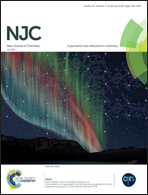A Co(ii) 1D coordination polymer constructed from 1,3-bisbenzyl-2-oxoimidazoline-4,5-dicarboxylic acid: crystal structure and magnetic properties†
Abstract
A new complex involving 1,3-bisbenzyl-2-oxoimidazoline-4,5-dicarboxylic acid (H2L) and a cobalt(II) metal ion designated [Co(L)(H2O)2]n has been synthesized under solvothermal conditions and characterized by elemental analyses, IR spectra, thermogravimetric analysis, single crystal X-ray diffraction and magnetization. The new compound crystallizes as pink crystals in an orthorhombic system with space group Pbca. A unit cell with 8 asymmetric units is present, each containing a Co(II) center with distorted octahedral geometry and a coordination sphere consisting of one nitrogen and five oxygen ligands. Bridging carboxylate groups are responsible for the formation of a 1D polymer. Adjacent chains are connected through OH⋯O hydrogen bonds involving coordinated water molecules leading to the formation of supramolecular arrangement. Low-temperature electron paramagnetic resonance (EPR) measurements identified that Co ions are in the divalent charge state in orthorhombic or less symmetry in high-spin (HS) configuration with principal values of g tensor of g1 = 5.5(2), g2 = 3.0(2) and g3 = 2.0(1). Magnetic susceptibility measurements as a function of temperature were analyzed by the standard Curie–Weiss law including diamagnetic contributions. Magnetic data were consistently explained by HS configuration of Co2+ ions with very small contribution of anti-ferromagnetic coupling.


 Please wait while we load your content...
Please wait while we load your content...